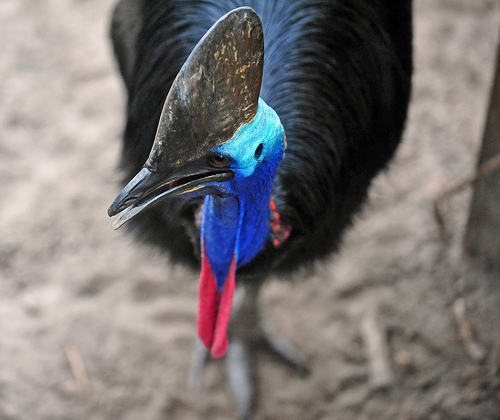Don’t feed, aggravate, threaten or approach a cassowary. You may not enjoy it.
- A cassowary is a species of flightless bird, native to New Guinea and northern Australia, that is typically hidden in tropical rainforest areas.
- The scientific name of a cassowary is Casuarius, from the Casuariidae family, and it is the only genus of birds in the family.
- There are three species of cassowaries still living – the northern, dwarf and southern, with the southern species being the most abundant.
- A cassowary’s diet consists primarily of fruit, and they also eat insects, vegetation, small animals and fungi.
- Cassowaries are large birds that range from 1.5 to 2 metres (4.9 to 6.6 feet) in height and weigh around 25 to 58.5 kilograms (55 to 129 pounds), ranking it in the top three extant birds in height, and in the top two in weight.

Image courtesy of Heather Paul/Flickr
- Cassowaries have dangerously clawed feet with three toes, which have been known to cause both animal and human fatalities.
- The plumage of a cassowary is primarily black, while the neck is generally a mixture of blues and reds, and the bird has a horn-like protrusion on its head, known as a ‘casque’.
- Habitat destruction and isolation, as well as hunting, have caused populations of some species of cassowary to decrease in numbers, and these are listed as vulnerable.
- Female cassowaries generally lay from three to eight eggs, that are coloured green to blue, and reach a length of 14 centimetres (5.5 inches), making them the third largest bird eggs in the world, and they are looked after by the males before and after they have hatched.
- A study in 2003 revealed that cassowaries expecting food from humans are most likely to attack, while 75% of all attacks on humans are a result of this, caused by their loss of shyness from humans feeding them.
Bibliography:
Cassowary, 2015, A-Z Animals, http://a-z-animals.com/animals/cassowary/
Cassowary, 2015, Wikipedia, https://en.wikipedia.org/wiki/Cassowary
Evans O, Southern Cassowary, 2015, Australian Museum, http://australianmuseum.net.au/southern-cassowary
Our Unique Big Bird, 2015, Australian Rainforest Foundation, http://www.arf.net.au/content.php?pageid=1280380330






